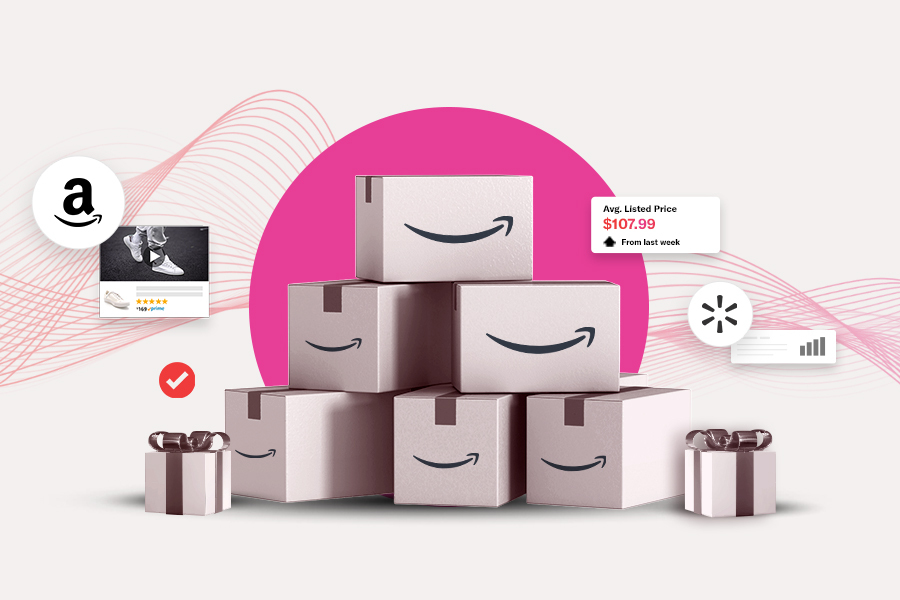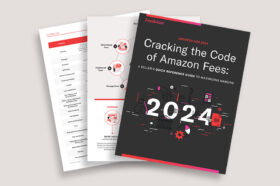
Holiday Prep Webinar Series: Optimizing Your Inventory for the Holiday Rush
Join Feedvisor’s experts on Wednesday, August 21st, to effectively prepare your inventory for holiday demand.
Register for the Webinar
Resources - Webinars
Part One: Protect Your Holiday Profits with Effective Inventory Optimization
Holiday sales are forecasted to reach a record-breaking $271.58 billion this year. Yet, failure to prepare can be costly, with rising storage fees potentially eroding your holiday earnings — making inventory optimization a crucial part of your Q4 prep.
In the first installment of our three-part Holiday Prep Webinar series, we share our best inventory optimization tactics to help you navigate the holiday season with confidence — plus, a live Q&A to answer your most pressing holiday prep questions.
This webinar was recorded live on August 21st. You can watch the recording below on demand or read through the provided transcript.
Marissa Incitti 00:00
Hi everybody, we’re going to give a couple of minutes to make sure everyone can join here. Thank you. Actually, it looks like we had a bunch of people join at the last minute here.
Marissa Incitti 00:18
We’re going to get started. Welcome to part one of our holiday prep series. We’re going to be discussing inventory for the holiday rush and how to optimize it. I’m Marissa, the associate director of content here at Feedvisor.
Marissa Incitti 00:31
And we have our Amazon expert, Ken Veseli, who’s been in the e -commerce industry with a decade of experience in Amazon. He’s one of our more senior employees here at Feedvisor. He’s a veteran of six years with us, which is amazing.
Ken Veseli 00:49
How are you doing? Nice to meet everybody.
Marissa Incitti 00:54
A brief overview of Feedvisor, for those of you who do not know us: We are the AI first optimization and intelligence platform for sellers, private labels, and brands on Amazon, Walmart, and other e -marketplaces.
Marissa Incitti 01:10
We’re actually one of the first that used AI, and we leverage data intelligence and automated actions in our platform, which helps you to deliver success from every e -commerce touch point, specifically from price optimization to advertising campaign efficiency and inventory health.
Marissa Incitti 01:28
We offer business driving clarity and control for every need. To get into it for our agenda for today, we are going to be discussing the importance of inventory optimization for the holidays, which, yes, may be a no brainer, but we’ll get to that.
Marissa Incitti 01:46
There’s an understanding of the holiday demand this year, some strategic inventory planning and how to do so, key deadlines for the major platforms, and how to actually leverage technology for inventory management.
Marissa Incitti 01:56
We’ll leave some time at the end for some questions, but please feel free to put them in the chat. We’ll have that enabled for you. To get right into it, why is inventory optimization important for the holidays?
Marissa Incitti 02:09
This seems like a no brainer, but the holidays are still the biggest sales opportunity for brands and sellers. This year, holiday e -commerce sales are predicted to break records, reaching 271 .58 billion, which is a 9 .5% increase from 2023.
Marissa Incitti 02:25
It’s actually been unheard of since 2021 with pre pandemic properties. Ken, how does inventory play a role in this holiday season?
Ken Veseli 02:35
Well, obviously, the more you stock out, the more you miss out on sales and opportunities, right? It’s obviously important to try to keep those stock levels up as high as possible. Another side effect of stocking out is, if you’re a buy box competitive seller, Amazon’s algorithm will hurt your sales for your specific competitive ASINs and give you less buy box share.
Ken Veseli 02:59
It’s really important to keep everything in stock. It’s obviously an important time of the year as buyers are buying gifts for other people. If it takes them a longer time to get their inventory, they can be dissatisfied, give you bad reviews, and you want to avoid that.
Ken Veseli 03:17
It’s also an optimal time to get rid of older inventory, dead stock, discontinued items from previous seasons.
Marissa Incitti 03:30
I imagine fees are the buzzword on everyone’s mind here. Fees are probably an important factor in inventory management as well?
Ken Veseli 03:36
Oh, yes. Amazon has made a lot of changes recently regarding their fees. An increased demand during the holidays equals more risk and high likelihood of potentially getting fees.
Ken Veseli 03:53
One of the things that you want to do is avoid dead stock and aged inventories, because it’s likely to sit in Amazon’s warehouse and your fees just accumulate over time. There are a lot of ways to get around that.
Ken Veseli 04:04
We’ll get into that later.
Marissa Incitti 04:07
Well, there seems like there’s tons of factors at play here. How can brands and merchants actually properly prepare for the holidays this season?
Ken Veseli 04:14
They want to use past sales data to forecast holiday demand and look at the products that sold the amount of sales they had and how long you’re running the sales for.
Marissa Incitti 04:25
What’s the proper way to use this data then, if we’re looking at it from this point of view?
Ken Veseli 04:31
You’re looking at historical data, but it’s important not to look too far back. We’re all aware Amazon’s a constantly changing landscape. Sellers are always making changes to the listings.
Ken Veseli 04:44
If you’re looking back at two to three years, I think that at that point, that data is pretty much irrelevant. What we’re seeing is the most recent yet data havoc for the previous year should be weighed the most or the heaviest.
Ken Veseli 04:57
Another thing that we’re seeing with a lot of customers that I work with is what they’re doing is bundle or pack items together to try to get out of that competitive landscape and try to create more control over their price. That has another impact on demand as well.
Marissa Incitti 05:20
I’m guessing forecasting is incredibly hard to demand. This is actually just looking at the past. What about accounting for all the changes that we’re seeing in the present here that’s happening right now?
Ken Veseli 05:31
You need to have an awareness of current trends and consumer behavior to forecast correctly. For instance, inflationary pressures haven’t let up yet. It leaves consumers with mixed feelings around spending versus saving when they’re heading into the holiday season.
Ken Veseli 05:47
41% intend to splurge on gifts while tightening elsewhere. On the other side, 46% of people say they really need to spend less on holiday gifts this year. But consumers still do continue to buy, they’re just spending less money when they’re buying.
Marissa Incitti 06:17
Over half of consumers are holding out for those big purchases on Black Friday, it seems like. What can we say about their changing holiday shopping behaviors?
Ken Veseli 06:26
Nearly 80% of consumers are reporting changing their holiday shopping behaviors to trade down, meaning buy a used item, an item that they really want with less features, that’s a little bit cheaper or easier for them to afford.
Ken Veseli 06:42
Some customers are buying refurbished items instead of buying new items. Refurbished items still have the same return policy. It’s a good way for them to save some money. Also, sellers can resell items that are pretty much brand new as used once they’re returned.
Ken Veseli 07:00
That’s just the trends we’re seeing. There’s multiple factors at play, like a lot of growth in the Chinese marketplaces.
Ken Veseli 07:17
They’re continuing to put pressure or actually try to chase Amazon’s market share. Two thirds of global shoppers report that prices dictate where they’re going to choose to shop with less than one third prioritizing quality of the goods.
Ken Veseli 07:36
63% of Western consumers plan to purchase from Chinese shopping applications for the holidays. It’s a presidential election year, which has always historically caused a little dip in consumer spending due to the heightened anxiety.
Ken Veseli 07:51
No one knows what’s going to happen. To mitigate that impact, marketers should launch their holiday campaigns earlier than usual, well before the election commotion starts. The earlier they start, this allows the initial consumer reactions to be measured and adjusted as needed.
Ken Veseli 08:15
We have a shortened holiday season as well. The 2024 holiday season is only 27 days between Thanksgiving and Christmas. The last time the holiday season was this short was in 2019 when marketers compensated by starting their holiday campaigns very early.
Ken Veseli 08:35
There will also most likely be an Amazon kickoff event in October. They’ve had an event in the last two years, so they will probably have another one this year, even though they haven’t announced anything yet.
Marissa Incitti 08:49
That seems like a lot for everyone to try to figure out. Given all these factors, trends, and everything going on, how can you strategically plan your inventory this year?
Ken Veseli 09:01
You need to have a detailed look into the cost and the capacity needed to store and move your volume of products, including fees such as inbound placement fees.
Ken Veseli 09:15
You want to look at buying trends from last year, what categories are attributed to doing well during the same time last year? You want to pay attention to trends from non -seasonal sales this year. What new trends can you incorporate into your holiday merchandising?
Ken Veseli 09:29
Consider your risk tolerance as it relates to stock outs and running out of inventory. If maintaining stock levels is crucial to your value prop, then you may overstock to buffer against supply chain disruptions.
Ken Veseli 09:44
If managing cashflow is more important, consider the opportunity cost of lost sales due to stock outs versus cashing out elsewhere in your business. Balancing these priorities can help you decide whether to prioritize inventory or cashflow.
Ken Veseli 09:59
Most sellers will prioritize inventory based on their anticipated best sellers and potentially cut back on items that may not be as popular to more effectively utilize their cashflow.
Ken Veseli 10:17
Stock cover. This is the length of time that your current inventory will last based on the sales velocity for that item. So for example, consider how long it will take to sell $10 ,000 worth of inventory for $20 ,000.
Ken Veseli 10:30
Whether it’s 7, 30 or 90 days, the longer the turnover, the higher the opportunity cost. Evaluate if there’s a faster selling product that could potentially yield the same result more quickly.
Marissa Incitti 10:44
Once you take into account these key considerations for your optimal inventory levels, what else can you do?
Ken Veseli 10:50
You want to use data analytics and forecasting models to predict demand. Getting an accurate projection of your holiday order volume requires forecasting. Use a combination of demand forecasting along with sales forecasting.
Ken Veseli 11:05
Consider any trends in the market and how they might affect demand. For example, self -care and wellness items are trending more than they have in the past. Before you begin forecasting, determine which ASINs you want to sell by looking at past sales and storage fees.
Ken Veseli 11:25
If there’s a mediocre product that has high storage fees, you will likely try to liquidate it instead of promoting it. To figure out what inventory you should have on hand, start with a forecast of future sales, sales in the coming 30, 60 or 90 days, which are based on past sales velocities and seasonality of those products.
Ken Veseli 11:47
For an accurate forecast, consider your sales velocity, which is the number of units sold per day. When you’re looking at the velocity, it’s important to understand to only look at sales per day while in stock.
Ken Veseli 12:04
Days that are not in stock should not be counted in your calculation because that doesn’t give you a true understanding of the demand of the products. In addition to sales velocity, there’s seasonality, which will inform the emphasis for past sales, like how much weight should you put into this?
Ken Veseli 12:22
Also, sales trends. If demand is steady or increasing in recent months, what are we trending towards?
Marissa Incitti 12:33
That seems like a lot of metrics to try to keep track of. Our replenishment makes it super easy to find all this data. I’m going to quickly show everybody because I think this is amazing.
Marissa Incitti 12:45
And Ken, I would love it if you can give us a quick walk through.
Ken Veseli 12:57
This is one of our more popular reports that few offer. We actually have some customers that run their entire business using this report. It gives you a breakdown of all the items that you’re selling on Amazon.
Ken Veseli 13:10
You have tons of trending information here. We’re going to give you your current inventory levels, all different categories of inventory, what’s fulfillable, what’s inbound, even if you have your own warehouse, how much you have in your warehouse, in addition to what Amazon knows about.
Ken Veseli 13:27
We give you all of the trending information. Your velocity the last 7, 30, 60, 90 days, your velocity change, which is, I believe, seven versus 30 days. How is it trending? Is the price trending up or down?
Ken Veseli 13:44
Are you at your floor or at your ceiling? Are you in range to help make recommendations? We’re going to give you, if you’re competing for the buy box, Amazon’s buy box share.
Ken Veseli 14:01
If Amazon is taking a higher percentage, you would likely want to order a little bit less of that. Traditionally, Amazon’s a very strong seller — you don’t like to compete against them when possible.
Ken Veseli 14:11
That would be an indicator to maybe order a little bit less of those items. Once again, trending data, sales data, profit margin data, and then average price changes as well.
Ken Veseli 14:25
We also have some really good recommendations. We’re not only breaking this up by vendor, we’re breaking it up by brand to make it easily sortable. You could also put in your desired days of coverage.
Ken Veseli 14:38
We’ll do the math for you and say, “if you want to maintain 50 days of coverage, we’re going to recommend the number of items to order.” Now, this calculation doesn’t always fully consider the previous year’s holiday season.
Ken Veseli 14:57
This is just looking at the last 30, 60, 90 days. You would look at this number and make a guesstimate of whether or not it should be above or below when you’re looking at your last year’s sales status during the holiday season.
Marissa Incitti 15:12
Awesome. Thank you so much, Ken. When you are keeping your inventory in mind here, I’m assuming you have to talk with your supplier here. What kinds of tips can you give us for lead times and supplier coordination?
Ken Veseli 15:30
You need to work closely with your suppliers to ensure that the delivery is timely. You want to touch base with your vendors, make sure that you’re all on the same page and what inventory you’re going to need.
Ken Veseli 15:44
Are pre -sale early order discounts available? Maybe you can get a better deal that way. Are there going to be changes to lead time? Do they anticipate any sort of production delays or back -order edition items?
Ken Veseli 15:57
You want to identify those items if possible. Will there be changes to shipping times when the holidays get closer and things are really busy? Do they have holiday shutdown dates? Are they open on Black Friday or between Christmas and New Year’s?
Ken Veseli 16:11
What’s their holiday schedule like? Do they offer expedited shipping? If you have an item that’s selling out quicker than expected, can you order more last minute? These are all good things to know beforehand.
Ken Veseli 16:25
You want to increase the lead time and days of stock as needed. Consider if you need to alter your days of stock. For example, if you typically plan to have 14 days of stock on hand, but you want to place an order to last 45 days during the holidays, you’ll need to alter your forecast.
Marissa Incitti 16:47
Now we’ve got some week by week inventory milestones that we’re going to make sure you have on hand here. The eight weeks before the holidays, make sure you’re finalizing inventory forecasts and placing those initial orders.
Marissa Incitti 17:03
That’s where looking at that data will really come in helpful. Then six weeks before the holidays, you’re going to review those inventory levels, make sure that everything is where you want it to be and adjust them if necessary, because you’re still having sales before the holidays.
Marissa Incitti 17:16
Four weeks before the holidays, you’re going to do that second inventory review and finalize those replenishments. Two weeks before the holidays, you’re going to make sure all your inventory is received and it’s ready for sale.
Marissa Incitti 17:27
We have some inventory deadlines here for the key platforms. For Amazon, October 19 is the deadline for inventory submissions. This is earlier this year, as last year it was a week later.
Marissa Incitti 17:42
The annual holiday peak fulfillment fee starts October 15 and will go all the way to January 14. So keep that in mind when you’re setting your sale prices. Walmart, we recommend that you send your inventory in concurrent with Amazon’s and any other platform that you’re on.
Marissa Incitti 17:58
Just make sure that you’re fully covered everywhere they’re selling. We do have some tips here for complying with Amazon’s inventory recommendations here. Ken, do you want to discuss some of these?
Ken Veseli 18:09
Yes, I think one of the most important points or important takeaways is that Amazon requires sellers to disclose the inventory sources. A big obstacle that some customers run into is they don’t have their paperwork in order.
Ken Veseli 18:27
Make sure that you have all of your product authenticity papers in order. Keep in mind, a receipt is not always equal to an invoice. When I worked with a bunch of customers, the last thing you want to do is get shut down during the busiest time in the season, right?
Ken Veseli 18:51
Make sure you have all your authenticity papers in order and ready to provide to Amazon should they request it. You should also take some proactive steps to verify the authenticity of the vendor’s product.
Ken Veseli 19:07
This includes using the manufacturer’s UPC code when listing the products, especially in categories like watches, where authenticity is extremely important. Confirm trustworthiness by providing Amazon with inventory source verification, test products such as pre owned watches for accuracy, obtain brand approval when connected to specific brands to ensure legitimacy.
Ken Veseli 19:36
Ensure that products sold on Amazon meet the platform’s conditional requirements. Very important, especially for categories such as the ones that have prohibitive ingredients like vitamins, make sure that the vitamins don’t contain any sort of ingredients that Amazon doesn’t allow you to send.
Ken Veseli 19:54
This is to try to maintain customer trust.
Marissa Incitti 20:07
This is a ton of information for sellers and brands to keep track of. How can they make this an easier process during the most stressful time of the year?
Ken Veseli 20:17
Feedvisor has a nice dashboard that can help you with managing your inventory.
Ken Veseli 20:33
We give a lot of data regarding sales history, profit history, but more importantly around inventory for every single SKU. We’re going to show you a full detailed view of the current inventory levels.
Ken Veseli 20:49
We’re going to give you an estimated days remaining of stock, tell you how many are fillable, how many are reserved. But more importantly, we can automate the pricing and help you ensure that you’re avoiding those fees and making the most amount of money possible when selling.
Ken Veseli 21:10
Specifically around inventory, Feedvisor has what’s called an inventory aware pricing strategy. Basically, if your FBA inventory gets into an excess state, we will automatically, and this is configurable by SKU, set up these SKUs to take certain actions.
Ken Veseli 21:35
If the FBA inventory is considered an excess, you can potentially leave it alone—maybe for an item you’re okay just leaving it in excess, maybe it’ll last the next year—or perhaps you want to accelerate sales.
Ken Veseli 21:49
You want to be more aggressive in your pricing and your advertising. You can tell the system, once this reads an excess inventory state, accelerate the sales for this item. On the converse side. if an item reaches low stock, you have a couple of different options. Do you want to basically, once again, ignore it? Do you wanna set the price to the ceiling, which should essentially just stop the sales.
Ken Veseli 22:17
You can maybe slow down your sales. So maybe be a little bit, push the prices up more frequently, try our higher price points to try to slow down your sales, which obviously in turn increases your margins.
Ken Veseli 22:31
It also helps reserve that inventory level. At the other end of that spectrum is if you’re running low, instead of it sitting there and accumulating more fees, why don’t we just liquidate it and get rid of it?
Ken Veseli 22:44
That also reduces your fees. Another cool feature that we have really specific to Feedvisor is tat you don’t need to wait for your inventory. What we have here is a report that shows you all your items that are in excess or all your items that are in low stock.
Ken Veseli 23:07
We also have the ability to show you proactively which items are trending towards those states before they even get there. We can proactively take action before you accumulate any fees. So If you’re trending to excess within 90 days of inventory, let’s take those excess inventory actions beforehand. Same thing trending towards low stock. Once again, at the SKU level, you can actually say, “I want to do this when it’s in this state or if it’s trending towards this state.”
Ken Veseli 23:44
We have all these tools available to you to help you reduce your fees and potentially make you more money.
Marissa Incitti 23:54
Wow. That’s great. Thank you, Ken. This is super informative. Just so you know, we do have a 14 day free trial. So if you did want to test this out, it’s free for 14 days. There’s no credit card required.
Marissa Incitti 24:04
It doesn’t hurt. Now’s the time to test this. I did want to say thank you, Ken. We’re going to take a look at some questions from the audience here. This is part one of our webinar series and there are two more sessions we’ll be having.
Marissa Incitti 24:19
The second one will be crafting winning ad campaigns for the holidays, which will be in September. We’ll be sending out invitations for this. The third one is on pricing strategies to maximize your holiday sales.
Marissa Incitti 24:29
We also have our inventory optimization guide, which includes how to mitigate and avoid some of those inventory fees, which you can feel free to download here. Let’s see some questions that came through.
Marissa Incitti 24:43
All right. The first one: is there any way to repurpose some return to inventory? And how can we turn used inventory into an advantage? Sorry, it’s a two -parter, Ken.
Ken Veseli 24:54
Okay, that’s a good question. Depending on the category, clothes being the primary exception, most of the time when items are returned to Amazon, they typically don’t allow you to resell them as new.
Ken Veseli 25:09
A good strategy is to re-list on Amazon in that used state. If you’re selling map items, a lot of vendors aren’t as aggressive as enforcing those map policies, so you can potentially still make some money off it, while it’s used, and maybe potentially sell it pretty easily,
Marissa Incitti 25:39
Okay. What specific data points are most valuable when forecasting holiday demand year for year?
Ken Veseli 25:53
We spoke about a lot of the specific data points that are most valuable. Year -over -year sales is really important. Performance during the previous holiday season is probably the best indicator you have.
Ken Veseli 26:09
Potentially looking at the competitive landscape if you can. You want to do some research into your category and items that you’re selling to determine how many other sellers are selling those same exact items or similar items.
Ken Veseli 26:27
And maybe year -over -year, is there more or less people in that area, right? Helping you get a better idea of reading between the lines of how you should forecast.
Marissa Incitti 26:38
How do you adjust your forecasting models to account for new products that don’t have historical sales data? That’s a tricky one.
Ken Veseli 26:49
If you have no sales data to look at, you’re guessing or trying to make it as best of an educated guess as possible. I would say look at your sales ranking. Has your sales ranking been trending up or trending down?
Ken Veseli 27:06
Typically, the better your sales ranking are, the more sales you’re going to have. Potentially try to do some research into a specific sales ranking for a category for even a different product. It can give you an understanding of what to expect for sales of your product.
Ken Veseli 27:28
I would say sales ranking would be a good data point to look at if there’s no sales history to look at.
Marissa Incitti 27:35
We just have two more questions here. What specific KPIs should be monitored daily during the holiday season to ensure inventory health and avoid those fees?
Ken Veseli 27:49
Preferably you’re using a tool, an automated tool like Feedvisor that does that for you. But I’d say manually, if you’re looking at things, would definitely be estimated days remaining in stock.
Ken Veseli 28:02
If you see an item that’s running out quicker than anticipated, you go back to your vendors and try to do an emergency order to get more because it’s exceeding expectations. If things are trending slower than anticipated, that estimated days of stock becomes too long, you want to be more aggressive in your pricing or advertising strategy to push the inventory along.
Marissa Incitti 28:32
Last question here. We already touched on this briefly, but how should I prepare for Amazon’s increased scrutiny on inventory sources, especially during the holiday season?
Ken Veseli 28:43
Don’t switch suppliers during the holiday season. Stay with what you know. You have a relationship with certain vendors, how to do business with them. I wouldn’t make any significant changes there.
Ken Veseli 29:03
Just to mention this again: invoices versus receipts. Make sure you have your invoices lined up in case someone does challenge the authenticity of your items.
Ken Veseli 29:16
You want to make sure that you avoid the risk of being shut down at all costs.
Marissa Incitti 29:22
That’s great advice. Thank you so much for attending. If you have any questions that we didn’t get to, please feel free to send them our way at info@ feedvisor.com Again, we have that lovely guide that you can download.
Marissa Incitti 29:36
Look out in your emails for invitations to the next two webinars and also the recording of this one in case you had to drop early. Thank you so much. We hope to hear from you again soon.
Marissa Incitti 29:48
Bye, everybody.

What’s on the Agenda:
- How to understand and forecast Holiday Demand: Explore how to use past sales data to accurately forecast holiday demand, as well as upcoming events like the Summer Olympics and presidential election.
- Strategic Inventory Planning: Learn how to ensure timely deliveries and optimal stock levels with a week-by-week review process
- Amazon and Walmart Inventory Deadlines: Understand the critical deadlines for Amazon and Walmart inventory submissions and how to ensure compliance with each platform’s requirements.
- Leverage AI-Powered Technology: Discover how dynamic pricing technology integrated with real-time inventory data can help minimize storage fees for the holidays.


